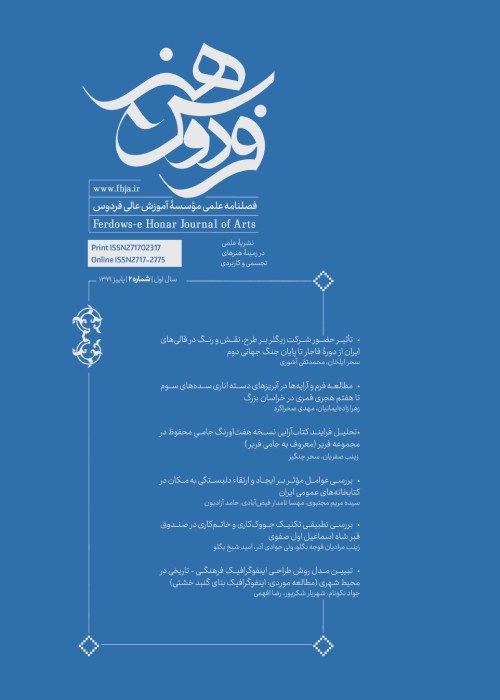Analysis the process of book arts in the Haft Awrang Manuscript )Freer Jami) in Freer gallery
Haft Awrang (Seven Thrones) is one of the most important works of Persian literature and is written by Abdolrahman Jami Which includes seven Masnavi and has composed from 1468 to 1485. There are an illustrated manuscript of this book that preserved in the Freer Gallery of art in Washington, D.C. this manuscript is known as both Sultan Ibrahim Mirza's Haft awrang and the Freer Jami. This valuable manuscript is one of the masterpieces of Safavid dynasty in Mashhad school of painting that produced with the support of Sultan Ibrahim Mirza nephew of Shah Tahmasp safavid. Mashhad Painting School flourished with support of Abolfath Sultan Ibrahim Mirza. He was the son of Bahram Mirza and the grandson of Shah Isma'il Safavi. Shah Tahmasp appointed Ebrahim Mirza as the ruler of Khorasan. This valuable manuscript wrote in Mashhad from 1556-1566 /963-972 AH. This work consists of more than three hundred pages with the decorated margins. The text is written in nasta'liq script by six of the most prominent calligraphers of that period. It has twenty-eight paintings that executed by famous artists such as Sheikh Mohammad, Sultan Mohammad Khandan, and Mirza Ali, son of Sultan Mohammad Tabrizi, Muzaffar Ali Agha and Aqa Mirk. Moheb Ali was in charge of the library and was responsible for providing the necessary items, including two different paper. The awareness of the process and order of decorations in royal manuscripts such as this manuscripts is important for today's research. In this study, we try to answer the following questions: what kind of decoration used in Freer Jami? What steps has been done and how? The results point out that each of decorative elements in this manuscript in addition to aesthetic function also had practical function. For example, headings were as an introduction to the literary text. Colophons provided valuable information about time, place, calligrapher, and sponsored names. Even the location of the illuminated panels that decorated verses had been done for a specific purpose. Their function is to introduce the presence of painting pages or colophons. The widest area for decoration in Islamic manuscripts, after the headings, are the margins around the texts and paintings. From the beginning of the fifteen century, the margins often decorated with golden designs and in various ways. Most of leaves in the Freer Jami have marginal decorations, which executed as the last stage of the illustration program. Most of the marginal motifs are floral that painted in gold. There are Animal figures in margins of some paintings. These marginal paintings have conceptual functions that related to the main painting. For example marginal animal motifs on some paintings show the combating of animals that indirectly related to the internal conflict in the middle paintings. These motifs probably have also symbolic meanings. Rubric or colorful titles are one of the most common decorative forms in Islamic manuscripts that convey the message of the text separately. Freer Jami has more than 750 decorative colorful titles. The number of them in each Masnavi and their location in the writing space completely depend on the text of each Masnavi. The three Masnavi are short and mostly educational texts that have more colorful titles. The other four Masnavi are in the form of interconnected narratives and stories written in longer sections. Therefore, they have less colorful titles. Each colorful title consists of one to four lines (sometimes more) that are placed inside a rectangular frame and extend along the two central columns of the text. Study of the decorative program of Freer Jami shows that in the first step, after preparing the sheets, the ruling the tables and writing the text and colophons and illuminating the verses were done respectively. The colorful titles, headings, and marginal drawings, as well as paintings, were executed after attaching the text sheets to the marginal sheets. In fact, any decorative items has both the aesthetic role and practical function in this manuscript. The production this manuscript during the nine years indicates the precise and detailed planning and flexibility of implementing decorative program in three cities by several calligraphers, painters, illuminators. It seems that the artists involved in this project had individual independence and in the performance of their works, in addition to following the common style of that period, had personal styles. Method of this study is descriptive – analysis and to access the information library and database resources is used.
- حق عضویت دریافتی صرف حمایت از نشریات عضو و نگهداری، تکمیل و توسعه مگیران میشود.
- پرداخت حق اشتراک و دانلود مقالات اجازه بازنشر آن در سایر رسانههای چاپی و دیجیتال را به کاربر نمیدهد.


